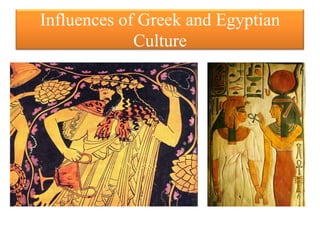
2c.8. foreign influences in pompeii art architecture & religion
- 1. Influences of Greek and Egyptian Culture
- 2. Greek Influences on ART
- 3. Greek Influences on ART •Greek influence is evident in the art, architecture and religion at P & H. Greeks had occupied the towns early in their history and Romans generally had a fascination with all things Greek. •Frescoes on the walls of houses and public buildings are an Italian practice, but they incorporate Greek elements – Greek columns and scenes related to Greek mythology and religion. (FIND EXAMPLES) Hercules, Nessus, And Deianira III Style, House of the Centaur, Pompeii
- 4. Fresco from the villa of P. Fannio Sinistore in Boscoreale, currently located in the Metropolitan Museum of Art, New York. This extraordinarily well preserved image makes remarkable use of perspective and colour to create an immersive. It is unknown what the function of the orb on the table is, perhaps it is a glass bowl with a butterfly pattern on it.
- 5. Greek Influences on ART •Statues of Greek heroes and gods – Apollo, Dionysus & Hercules, also provide evidence of Greek influence. Many are thought to be copies of Greek originals. •Frescoes and Mosaics feature aspects of Greek drama which had been absorbed into Roman culture – masks of comedies and tragedies. Comedy mask. Roman mosaic from the Casa del Fauno (VI •Library of Greek works and 12, 2-5) in Pompeii. copies of Greek statues found Museo Archeologico Nazionale (Naples) in THE HOUSE OF PAPYRI
- 6. Theatre mask. Roman fresco from Pompeii. Museo Archeologico Nazionale (Naples) Female theatre mask. Roman fresco from Casa del Bracciale d'Oro (VI 17, 42) in Pompeii.
- 7. Egyptian Influences on ART
- 8. Egyptian Influences on ART • Once Egypt became part of the Roman Empire and Egyptian craftsmen began working in Italy, Egyptian scenes and motifs became very fashionable • Mosaics featured Egyptian plants and animals – THE NILE MOSIAC IN THE HOUSE OF THE FAUN THE NILE MOSIAC IN THE HOUSE OF THE FAUN
- 9. Egyptian Influences on ART The spectacular ALEXANDER MOSAIC (ALSO FROM THE HOUSE OF THE FAUN) was created by Egyptian craftsmen. It depicts the battle between Alexander the Great and Darius III of Persia
- 10. Alexander the Great– Alexander Mosaic – House of the Faun
- 11. Darius III – Alexander Mosaic – House of the Faun
- 12. Egyptian Influences on ART • Statuettes and amulets have been found showing the Egyptian god BES, protector of women and children. Used to ward off evil spirits. • The Egyptian goddess ISIS was very popular in P & H. The goddess and her worship were featured in frescoes and statues – HOUSE OF OCTAVIUS QUATRIO IN POMPEII • Decorative use of Sphinxes and other Egyptian motifs in mosaics and frescoes Roman fresco in the temple of ISIS in Pompeii. Io is welcomed in Egypt by ISIS. BES
- 13. ARCHICTECTURE • Temples reflect Greek influences – the TEMPLE OF APOLLO has a peristyle and use of columns which are Greek, blended with a high platform and small cella which are Roman in style. Temple of Apollo - Pompeii
- 14. ARCHICTECTURE • Public porticoes and buildings using columns, such as the basilica, used all 3 types of Greek columns – DORIC, IONIC and CORINTHIAN
- 15. ARCHICTECTURE • The peristyle structure – a columned portico around an internal courtyard – is a Greek architectural feature which is common in large public complexes such as the BATHS and PALAESTRA Peristyle garden from Pompeii Peristyle ideas used in the PALAESTRA - Pompeii
- 16. ARCHICTECTURE • Theatres also reflect Greek influence, compressing the major elements of Greek theatre design into one – theatron, orchestra and skene. The quadriporticus with DORIC colonnade, built adjacent to the theatres was also of Greek design quadriporticus
- 17. RELIGION Temple of Apollo - Pompeii
- 18. RELIGION • Greek influence evident in the older temples featuring Greek deities which were later adopted into Romanised forms. Some retained their Greek names – APOLLO, or were given Roman names but remained essentially Greek – Aphrodite became Venus, Dionysus became Bacchus Bacchus and Mt Vesuvius and Venus
- 19. RELIGION • The Egyptian Goddess ISIS, popular among women and sailors, had a large following in both towns. Dozens of household shrines to ISIS have been found in Pompeii. A shrine to ISIS, SERAPIS and ANUBIS was found in the HOUSE OF THE GILDED CUPIDS
- 20. RELIGION • There was a substantial temple to ISIS in Pompeii, which contained statues to ISIS, OSIRIS and HORUS. It was a banquet hall and a small room for storing NILE WATER for purification.
- 21. RELIGION • The Temple of ISIS had been badly damaged in the earthquake of 62 but had been fully reconstructed by the time of the eruption in 79